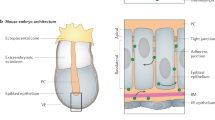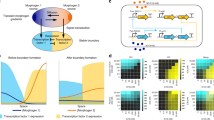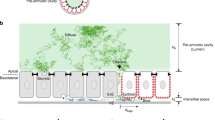Abstract
Development of multicellular organisms depends on the proper establishment of signaling information in space and time. Secreted molecules called morphogens form concentration gradients in space and provide positional information to differentiating cells within the organism. Although the key molecular components of morphogen pathways have been identified, how the architectures and key parameters of morphogen pathways control the properties of signaling gradients, such as their size, speed, and robustness to perturbations, remains challenging to study in developing embryos. Reconstituting morphogen gradients in cell culture provides an alternative approach to address this question. Here we describe the methodology for reconstituting Sonic Hedgehog (SHH) signaling gradients in mouse fibroblast cells. The protocol includes the design of morphogen sending and receiving cell lines, the setup of radial and linear gradients, the quantitative time-lapse imaging, and the data analysis. Similar approaches could potentially be applied to other cell–cell communication pathways.
Access this chapter
Tax calculation will be finalised at checkout
Purchases are for personal use only
Similar content being viewed by others
References
Rogers KW, Schier AF (2011) Morphogen gradients: from generation to interpretation. Annu Rev Cell Dev Biol 27:377–407
Wartlick O, Kicheva A, González-Gaitán M (2009) Morphogen gradient formation. Cold Spring Harb Perspect Biol 1:a001255
Perrimon N, McMahon AP (1999) Negative feedback mechanisms and their roles during pattern formation. Cell 97:13–16
Freeman M (2000) Feedback control of intercellular signalling in development. Nature 408:313–319
Li P, Markson JS, Wang S, Chen S, Vachharajani V, Elowitz MB (2018) Morphogen gradient reconstitution reveals Hedgehog pathway design principles. Science 360:543–548
Patten I, Placzek M (2000) The role of sonic hedgehog in neural tube patterning. Cell Mol Life Sci 57:1695–1708
Nüsslein-Volhard C, Wieschaus E (1980) Mutations affecting segment number and polarity in Drosophila. Nature 287:795–801
Nakano Y, Guerrero I, Hidalgo A, Taylor A, Whittle JR, Ingham PW (1989) A protein with several possible membrane-spanning domains encoded by the Drosophila segment polarity gene patched. Nature 341:508–513
Hooper JE, Scott MP (1989) The Drosophila patched gene encodes a putative membrane protein required for segmental patterning. Cell 59:751–765
Hui C-C, Angers S (2011) Gli proteins in development and disease. Annu Rev Cell Dev Biol 27:513–537
Chamberlain CE, Jeong J, Guo C, Allen BL, McMahon AP (2008) Notochord-derived Shh concentrates in close association with the apically positioned basal body in neural target cells and forms a dynamic gradient during neural patterning. Development 135:1097–1106
Dessaud E, Yang LL, Hill K, Cox B, Ulloa F, Ribeiro A, Mynett A, Novitch BG, Briscoe J (2007) Interpretation of the sonic hedgehog morphogen gradient by a temporal adaptation mechanism. Nature 450:717–720
Averbukh I, Ben-Zvi D, Mishra S, Barkai N (2014) Scaling morphogen gradients during tissue growth by a cell division rule. Development 141:2150–2156
Spassky N, Han Y-G, Aguilar A, Strehl L, Besse L, Laclef C, Ros MR, Garcia-Verdugo JM, Alvarez-Buylla A (2008) Primary cilia are required for cerebellar development and Shh-dependent expansion of progenitor pool. Dev Biol 317:246–259
Goodrich LV, Johnson RL, Milenkovic L, McMahon JA, Scott MP (1996) Conservation of the hedgehog/patched signaling pathway from flies to mice: induction of a mouse patched gene by Hedgehog. Genes Dev 10:301–312
Rohatgi R, Milenkovic L, Scott MP (2007) Patched1 regulates hedgehog signaling at the primary cilium. Science 317:372–376
Goedhart J, von Stetten D, Noirclerc-Savoye M, Lelimousin M, Joosen L, Hink MA, van Weeren L, Gadella TWJ Jr, Royant A (2012) Structure-guided evolution of cyan fluorescent proteins towards a quantum yield of 93%. Nat Commun 3:751
Gerety SS, Breau MA, Sasai N, Xu Q, Briscoe J, Wilkinson DG (2013) An inducible transgene expression system for zebrafish and chick. Development 140:2235–2243
Szymczak AL, Workman CJ, Wang Y, Vignali KM, Dilioglou S, Vanin EF, Vignali DAA (2004) Correction of multi-gene deficiency in vivo using a single’self-cleaving'2A peptide—based retroviral vector. Nat Biotechnol 22:589–594
Balaskas N, Ribeiro A, Panovska J, Dessaud E, Sasai N, Page KM, Briscoe J, Ribes V (2012) Gene regulatory logic for reading the Sonic Hedgehog signaling gradient in the vertebrate neural tube. Cell 148:273–284
Li C, Hirsch M, Carter P, Asokan A, Zhou X, Wu Z, Samulski RJ (2009) A small regulatory element from chromosome 19 enhances liver-specific gene expression. Gene Ther 16:43–51
Griesbeck O, Baird GS, Campbell RE, Zacharias DA, Tsien RY (2001) Reducing the environmental sensitivity of yellow fluorescent protein. Mechanism and applications. J Biol Chem 276:29188–29194
Ding S, Wu X, Li G, Han M, Zhuang Y, Xu T (2005) Efficient transposition of the piggyBac (PB) transposon in mammalian cells and mice. Cell 122:473–483
Bintu L, Yong J, Antebi YE, McCue K, Kazuki Y, Uno N, Oshimura M, Elowitz MB (2016) Dynamics of epigenetic regulation at the single-cell level. Science 351:720–724
Acknowledgments
We thank the Michael Elowitz lab where the method was initially developed. We also thank Yaron Antebi for providing the single-cell segmentation/tracking program. This work was funded by NIH Pathway to Independence Career Award 1R00HD087532 and Mathers Foundation MF-1905-00336.
Author information
Authors and Affiliations
Corresponding author
Editor information
Editors and Affiliations
Rights and permissions
Copyright information
© 2021 The Editor(s) (if applicable) and The Author(s), under exclusive license to Springer Science+Business Media, LLC, part of Springer Nature
About this protocol
Cite this protocol
Kim, J.S., Pineda, M., Li, P. (2021). Reconstitution of Morphogen Signaling Gradients in Cultured Cells. In: Ebrahimkhani, M.R., Hislop, J. (eds) Programmed Morphogenesis. Methods in Molecular Biology, vol 2258. Humana, New York, NY. https://doi.org/10.1007/978-1-0716-1174-6_4
Download citation
DOI: https://doi.org/10.1007/978-1-0716-1174-6_4
Published:
Publisher Name: Humana, New York, NY
Print ISBN: 978-1-0716-1173-9
Online ISBN: 978-1-0716-1174-6
eBook Packages: Springer Protocols




